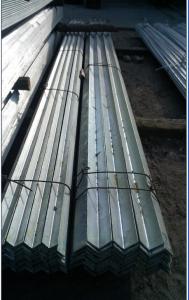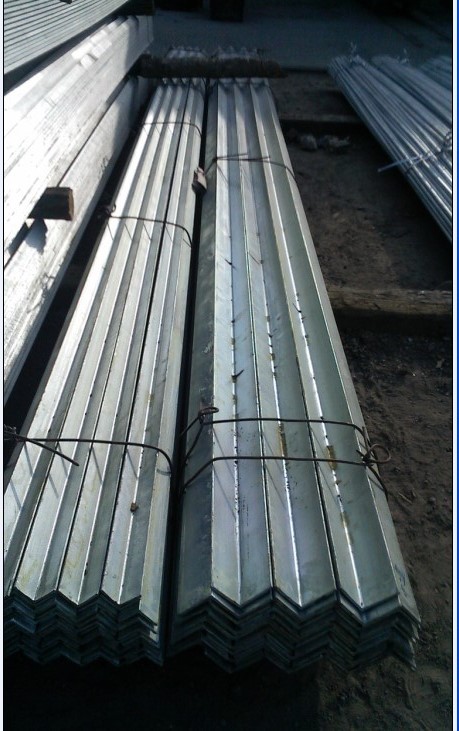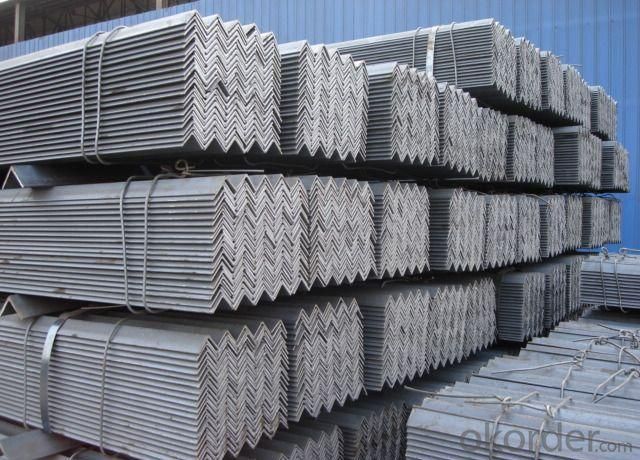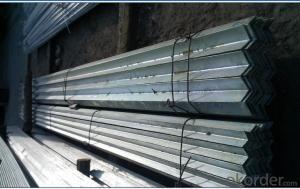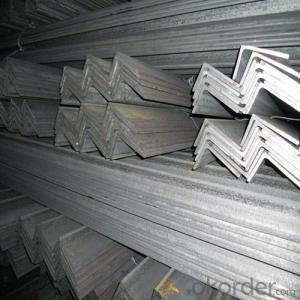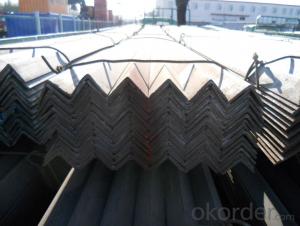GB Q235 Steel Angle
OKorder Service Pledge
OKorder Financial Service
You Might Also Like
Specifications of Equal Angle Steel
1.Standards:GB
2.Length:6m,9m,12m
3.Material:GBQ235,Q345 or Equivalent
4. Size: 50*50mm, 60*60mm, 63*63mm
Usage & Applications of Equal Anlge Steel
Trusses;
Transmission towers;
Telecommunication towers;
Bracing for general structures;
Stiffeners in structural use.
Packaging & Delivery of Equal Angle Steel
1. Transportation: the goods are delivered by truck from mill to loading port, the maximum quantity can be loaded is around 40MTs by each truck. If the order quantity cannot reach the full truck loaded, the transportation cost per ton will be little higher than full load.
2. With bundles and load in 20 feet/40 feet container, or by bulk cargo, also we could do as customer's request.
3. Marks:
Color mark: There will be color marking on both end of the bundle for the cargo delivered by bulk vessel. That makes it easily to distinguish at the destination port.
Tag mark: There will be tag mark tied up on the bundles. The information usually including supplier logo and name, product name, made in China, shipping marks and other information request by the customer.
If loading by container the marking is not needed, but we will prepare it as customer request.
*If you would like to get our price, please inform us the size, standard/material and quantity. Thank you very much for your attention.
- Q: Can steel angles be used as supports for signage or lighting fixtures?
- Yes, steel angles can be used as supports for signage or lighting fixtures. Steel angles are commonly used in construction and can provide strong and sturdy support for various applications, including signage and lighting fixtures.
- Q: How do steel angles contribute to the overall stability of a structure?
- The overall stability of a structure is significantly influenced by steel angles, which serve multiple purposes. Primarily, steel angles are widely used as structural members in various applications, including building frames, bridges, and towers. Their L-shaped profile offers exceptional strength and load-bearing capabilities, making them ideal for supporting heavy loads and resisting bending or buckling. An important role of steel angles is to provide structural support and stability by distributing the load evenly across different components of the structure. By connecting elements like beams, columns, and girders, steel angles effectively transfer and resist weight and forces acting on the structure, thereby preventing potential collapse or failure. Furthermore, the overall rigidity and stiffness of a structure are enhanced by steel angles. When diagonal bracing elements made of steel angles are added, the structure becomes more resistant to lateral forces such as wind or earthquakes. These diagonal braces create a stable triangular configuration capable of withstanding horizontal loads. Consequently, the increased stability and resistance to lateral forces greatly contribute to the overall safety and durability of the structure. In addition, steel angles play a crucial role in mitigating torsional forces in a structure. Torsion occurs when one end of a structural member is twisted while the other end remains fixed, resulting in a twisting moment being applied to the structure. To counteract these torsional forces, steel angles can be strategically placed and connected, preventing excessive twisting or deformation that could jeopardize the structure's stability. To summarize, steel angles are vital components that contribute to the overall stability of a structure through various means. They offer structural support, efficiently distribute loads, enhance rigidity, resist lateral forces, and mitigate torsional forces. By incorporating steel angles into the design and construction of a structure, engineers can ensure its long-term stability, safety, and durability.
- Q: Can steel angles be used for architectural purposes?
- Yes, steel angles can be used for architectural purposes. They are commonly used in the construction industry for various architectural applications such as support brackets, frames, and reinforcements. Steel angles provide structural stability and can be easily customized and integrated into architectural designs to meet specific requirements.
- Q: What are the different types of steel angles used in material handling systems?
- There are various types of steel angles commonly used in material handling systems. These angles are used to provide structural support and reinforcement to the system. Here are some of the different types of steel angles used in material handling systems: 1. Equal Leg Angles: These angles have equal sides and are commonly used in material handling systems to provide structural support. They are typically used in applications where the load is evenly distributed. 2. Unequal Leg Angles: As the name suggests, these angles have unequal sides. They are often used in material handling systems where the load is not evenly distributed. Unequal leg angles provide flexibility in designing and constructing the system to accommodate different load requirements. 3. L-Shaped Angles: L-shaped angles are commonly used in material handling systems to create corners or to connect different components together. These angles provide stability and reinforcement to the system, especially at joints and intersections. 4. Slotted Angles: Slotted angles are versatile steel angles that feature a series of holes along their length. These holes allow for easy adjustment and customization of the material handling system. Slotted angles are often used to create shelving units, workbenches, and other storage solutions in material handling systems. 5. Perforated Angles: Perforated angles are similar to slotted angles but have a pattern of holes across their surface. These holes allow for better ventilation and drainage in the material handling system. Perforated angles are commonly used in applications where airflow or liquid drainage is important, such as in conveyor systems or storage racks. 6. Stainless Steel Angles: Stainless steel angles are highly resistant to corrosion and are commonly used in material handling systems that operate in harsh environments or require hygienic conditions. They are ideal for applications where cleanliness, durability, and resistance to rust are essential. These are just a few of the many types of steel angles used in material handling systems. The choice of angle depends on the specific requirements of the system, including load capacity, structural integrity, and environmental factors. It is important to consult with a professional engineer or designer to determine the most suitable type of steel angle for a material handling system.
- Q: How do steel angles behave under seismic forces?
- Steel angles are commonly used in construction to provide structural support and stability. When subjected to seismic forces, steel angles behave in a predictable manner. Their design and placement allow them to absorb and distribute the energy generated by seismic activity, thereby minimizing damage and ensuring the overall structural integrity of the building. Steel angles are able to resist bending, shearing, and torsion forces, making them a reliable choice for seismic-resistant construction.
- Q: How to determine the neutral axis of the angle bar?
- The neutral axis of angle iron or channel steel needs to be calculated, but it can be checked directly.
- Q: How do steel angles perform under lateral or wind loading conditions?
- Steel angles are commonly used in construction and engineering applications due to their strength and versatility. When it comes to lateral or wind loading conditions, steel angles perform exceptionally well. Lateral loading refers to forces that act in a horizontal direction, perpendicular to the axis of the angle. Steel angles, with their inherent rigidity and ability to resist bending, are capable of withstanding significant lateral loads. This makes them ideal for applications such as bracing systems, support structures, and framing components that need to resist wind, seismic, or other lateral forces. Similarly, steel angles excel in wind loading conditions. Wind exerts a strong lateral force on structures, and steel angles can effectively counteract these forces. By securely fastening steel angles to the structure, they can provide stability and prevent the structure from being compromised by wind-induced vibrations or even collapse. The performance of steel angles under lateral or wind loading conditions can be further enhanced through proper design and installation. Engineers often consider factors such as the size and thickness of the angle, the type and quality of the steel used, and the connection details. By carefully analyzing the specific loading conditions and selecting appropriate steel angles, engineers can ensure that structures remain stable and safe, even under extreme lateral or wind loads. Overall, steel angles are highly reliable and durable when it comes to lateral or wind loading conditions. Their robustness, coupled with their cost-effectiveness and ease of installation, makes them a preferred choice in many construction and engineering projects.
- Q: What are the load-bearing capacities of different steel angle sizes?
- The load-bearing capacities of different steel angle sizes vary depending on factors such as the thickness of the steel, the length of the angle, and the type of load being applied. Generally, larger and thicker steel angles have higher load-bearing capacities. It is recommended to consult engineering tables, codes, or a structural engineer to determine the specific load-bearing capacity for a particular steel angle size.
- Q: Are steel angles suitable for architectural cladding?
- Yes, steel angles can be suitable for architectural cladding. Steel angles offer structural support and can be used to create clean lines and sharp corners in architectural designs. They are durable, weather-resistant, and can be customized to match the desired aesthetic. Additionally, steel angles provide versatility in terms of installation and can be easily attached to different building materials.
- Q: Can steel angles be used in agricultural applications?
- Yes, steel angles can be used in agricultural applications. Steel angles are versatile and durable structural components that can be used in various agricultural applications such as constructing farm buildings, barns, sheds, and livestock enclosures. They provide strength and stability to the structures, making them suitable for withstanding the heavy loads and harsh weather conditions commonly found in agricultural environments. Additionally, steel angles can be easily welded or bolted together, allowing for flexibility and ease of construction. Their corrosion-resistant properties also make them ideal for outdoor agricultural applications where exposure to moisture and chemicals is common. Overall, steel angles are a reliable and cost-effective choice for agricultural construction needs.
Send your message to us
GB Q235 Steel Angle
OKorder Service Pledge
OKorder Financial Service
Similar products
Hot products
Hot Searches
Related keywords
